






Learn wow to use the subjective power of movement and composition to guide the viewer’s attention and emotions.
SOCIAL
YouTube: 1PersonCrew
Instagram: @1PersonCrew
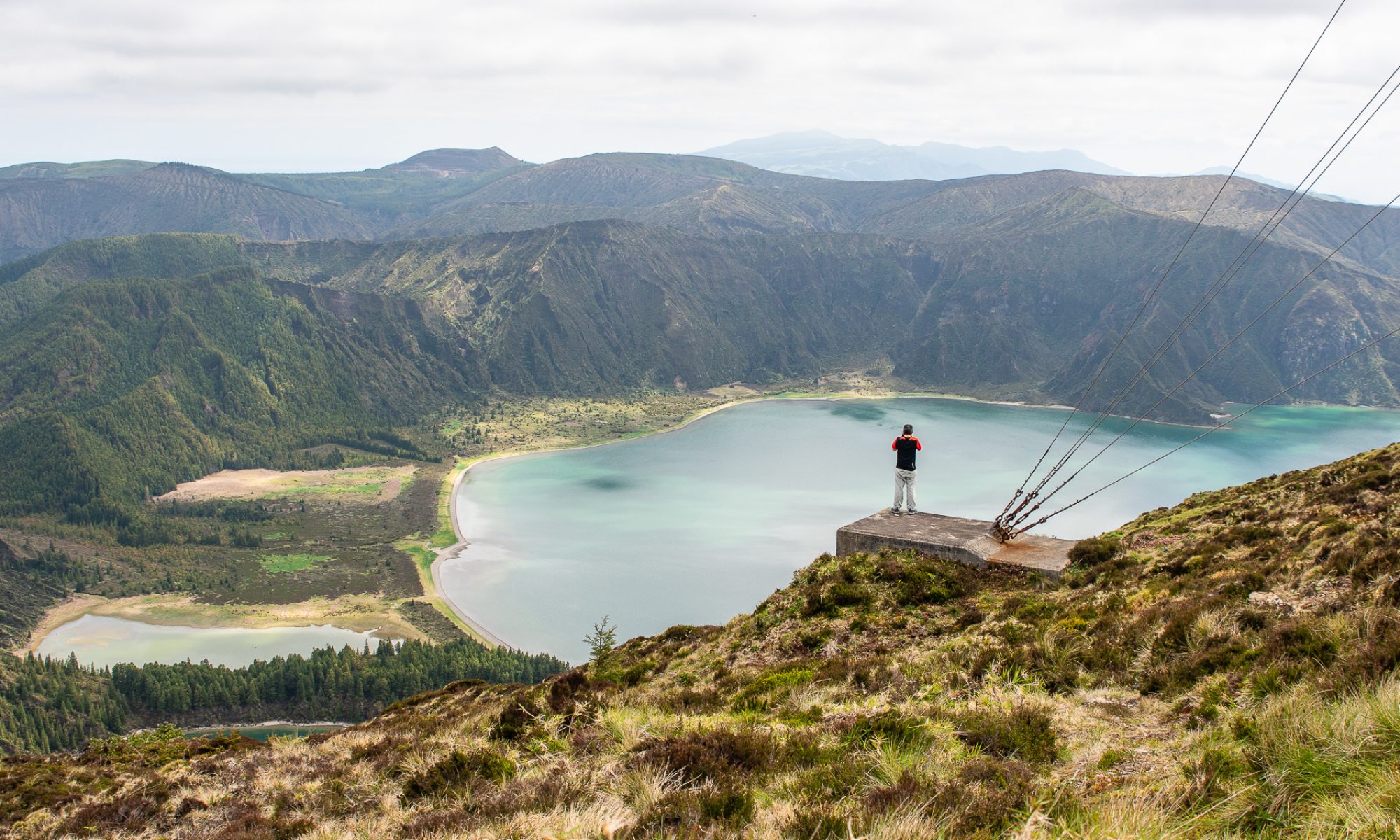
The ultimate filmmaking resource on how to do more with less.







Learn wow to use the subjective power of movement and composition to guide the viewer’s attention and emotions.
SOCIAL
YouTube: 1PersonCrew
Instagram: @1PersonCrew






It doesn’t take a Hollywood budget to make to make the most of available light, and to learn simple tricks to reveal or obscure objects and subjects in your scene. Here’s your chance to learn field tested techniques to manipulate moods, add depth, and enhance your overall production with a few lighting tweaks.
https://www.linkedin.com/learning/lighting-design-for-video-productions/welcome
SOCIAL
YouTube: 1PersonCrew
Instagram: @1PersonCrew
There are SO many camera bags, all claiming to be THE perfect one for your specific needs. Obviously that’s impossible. So which camera bags are best for the 1 Person Crew and why?
I’ve owned dozens of camera bags in the past 20 years. I actually used to work at a camera store so I was able to field test ANY bag I wanted for a weekend, and then buy it with a significant discount. Needless to say I ended up with a closet full of them, from very uncomfortable “Sling bags” to extra heavy “hard cases” to even a “floating backpack” that I used once….
Over the years I’ve been increasingly demanding when it comes to buying equipment, and this includes camera bags.
I’m always looking for three things: I want the bag to be comfortable, to have the right features (like compartments that are easy to reach for me, but not for pickpockets), and “the look.” I want something that looks nice, but doesn’t scream “Hey! I have $20,000 right here!”
When it comes to brands, I also have used them all. I want a company that keeps innovating and taking risks, that is using high-quality materials, but also offers a fair price, customer service and warranty. This is easier said than done, of course.
At my workshops I often hear attendees complain “$400 for a bag?!?!?! That’s a lot of money!”
But is it? If I’m putting $20,000, $30,000 or even $40,000 inside a bag that will take some serious beating for 5 years, is $400 really a bad investment? I don’t think so.
So, I currently use three kinds of bags, all made by the same company. The smallest bag is a Messenger style bag. That’s the one I use pretty much every day, for my laptop when I’m not shooting, and with a very compact setup, especially if I need very quick access to my camera.

What’s inside that Mesenger Bag? Watch the video below to find out:
The second bag is a video backpack. That’s the one I’m taking with me pretty much every time I leave town. It goes next to me in a taxi, under my seat on a plane, and on my back the rest of the time. That bag NEVER leaves my side.

The third bag is a hybrid bag, which means it’s a rolling case AND a backpack. That’s my carry-on bag, that rolls 90% of the time, and it’s on my back when I’m dealing with sand in Mexico, snow in Chicago, cobblestones in Lisbon, stairs in New York’s subway, and mud in Bali.

So, what about you? Do you have a favorite bag or packing tip? If so, please share your comments below.
DISCLAIMER
This article is not paid or sponsored by anyone. It reflects my own independent opinion. I only recommend companies and products that I trust. Some links might be affiliates, which means I may get a few pennies if you decide to purchase something.
Thanks in advance for your support!
MY VIDEO GEAR
Amazon
ONLINE COURSES
Lynda.com
Mini Tutorials
LinkedIn Learning
SOCIAL
YouTube: 1PersonCrew
Instagram: @1PersonCrew
I recently presented a “Filmmaking Essentials for Photographers” workshop at Adorama in New York City. In case you are interested, you can watch the event here.

The premise of the event was simple: there are so many things we “need” to shoot video; from the obvious ones, like a camera and a lens, to other more obscure items like a versatile audio setup and a compact, fast and reliable hard drive to edit on the road. With so many brands, models, and price points to choose from, where do you even start?
I’ll go over the differences and similarities between shooting stills vs. motion, but a big section of the event will be focused on gear. What should you buy when getting started? When to upgrade? And which other tools should you seriously consider, even if you are an experienced pro?
After two decades of professional experience, I’ve (almost) mastered the art of packing everything I need into a single video backpack, messenger bag, or carry-on. It obviously depends on the project’s complexity, length and if I’m flying, driving, or using public transportation, but all of these set ups have one thing in common; there’s zero waste. I only bring with me what I consider truly essential, everything else stays behind.
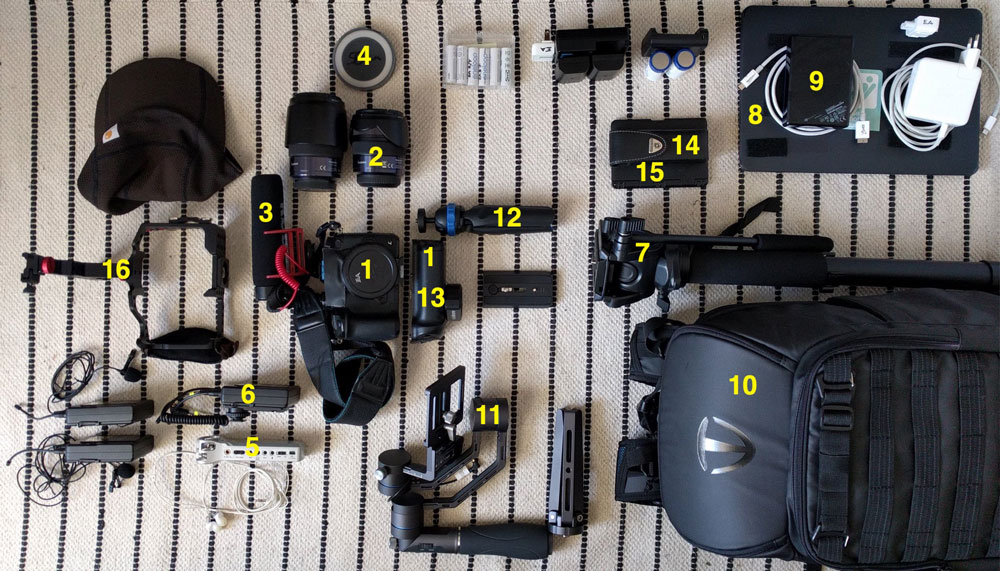
This specific setup will allow me to shoot for a full day without recharging batteries, record a two people interview while getting very clean scratch sound, have a focal range from 24mm to 200mm (2.8 all the way), very quickly capture steady shots with my monopod as well as super stable gimbal shots. The best part is that everything fits in ONE backpack that goes under my airplane seat!
Want to know more? Register here for this FREE event, watch this online course on packing, check my complete kit, or buy the book (PDF, Kindle and Paperback).
ONLINE COURSES
Lynda.com
Mini Tutorials
LinkedIn Learning
MY VIDEO GEAR
Amazon
SOCIAL
YouTube: 1PersonCrew
Instagram: @1PersonCrew
DISCLAIMER
This article is not paid or sponsored by anyone. It reflects my own independent opinion. I only recommend companies and products that I trust. Some links might be affiliates, which means I may get a few pennies if you decide to purchase something.
Thanks in advance for your support!
I have been studying Ira Glass and Anthony Bourdain for a very long time.
Ira Glass is very well known in the U.S. because he is the producer and host of a very well-known radio show called “This American Life.” Bourdain was a celebrity chef, writer, host and producer of travel programs for The Travel Channel and CNN, exploring cultures and foods around the world.

The way the show works is as follows: a team of 12 people go out and find simple stories about everyday topics with normal subjects and characters, and produce fascinating stories about them.
For example, every highway has something called roadkill, which are the dead animals like deer, cats or dogs on the side of the road. Well, someone needs to go and pick them up. So many years ago, Ira Glass produced a story about the person who does that job, and it’s very appropriately called “Dead animal man.”
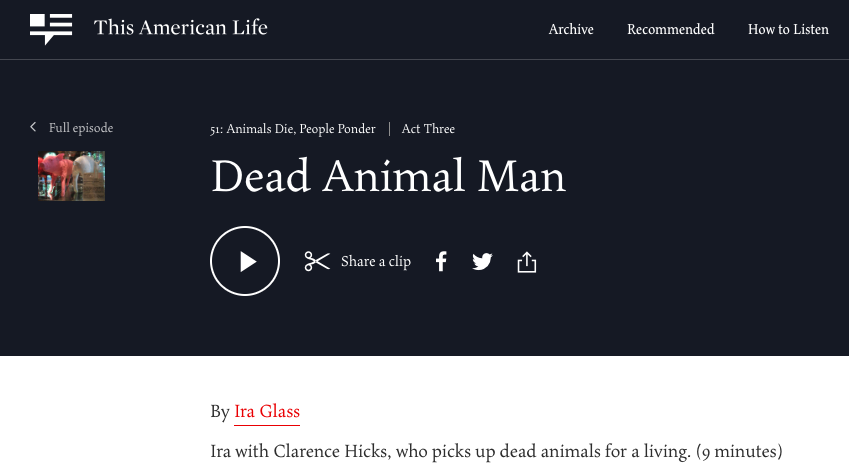
“I’d have given half my life for that squirrel at one time. I was a prisoner during the Korean War and I’d set up off at Han River and watch seagulls fly over, I’ll be laying there thinking I fry one. That’s how hungry I was.”
Clarence Hicks
The way Ira Glass asks and sequences the questions, and the kind of sounds he includes are all masterfully executed.
Ira Glass and his team approach pre-production in a similar way. Every Monday morning a group of 12 people meet, and each person pitches at least one story idea. As a group they pick and choose the best six ideas, and spend the rest of the week producing them. The following Monday they go over the six stories, pick the best one or two, and only those are the ones that get broadcasted. The other stories either die or get a second chance in the future.
The stories we hear on “This American Life” are incredibly good, not only because all the team members are super talented and work extremely hard, but also because they start with 12 stories, narrow them down to six and then hand-picked the best two.
Bourdain stories, on the other hand, were all about traveling to different locations and exploring local food.
“A prego is a steak sandwich slash booze mop that puts you right over the edge in a protein overdose, which is to say, happiness.”
The setup for all Bourdain’s shows was fairly simple. It was always Bourdain with a guest, talking about politics, culture and current events over food.
The way the shows were shot was very efficient. Two cinematographers recording sound on camera, and one director/producer/C Cam operator. Most of the time they used available light.



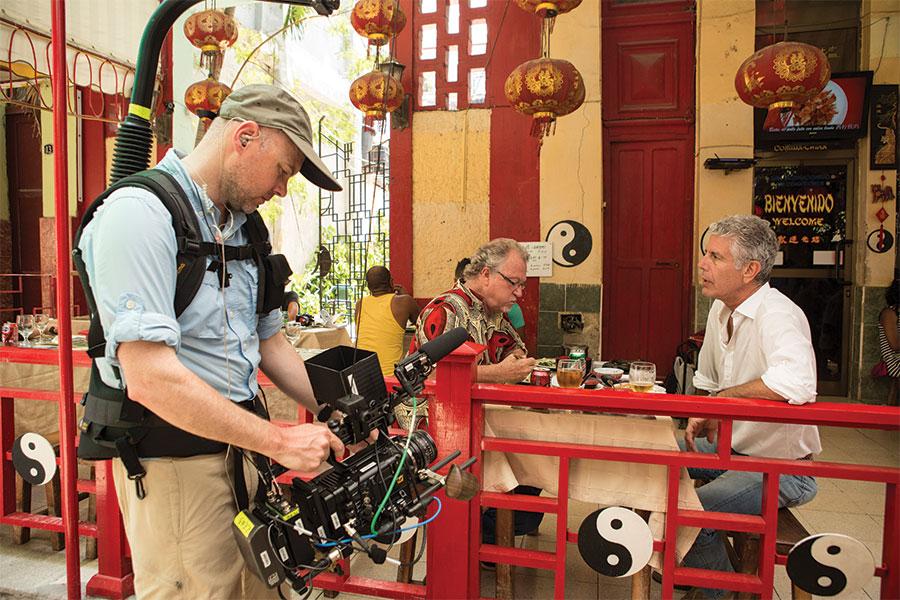
When one watches the show it’s hard to believe they only had a 2 or 3-person crew. And I believe a reason to achieve this high level of production is possible because they started researching each location a month before production, and spent a lot of time in pre-production.
Before each shoot the crew had pre-pro meetings to discuss core concepts, looks, shooting approaches. They found inspiration in movies, songs, books and researched about the history and the place in its current state. Yet, they didn’t use scripts, and Bourdain never wrote anything for a show beforehand.
“If you think you’ve already figured out what the show’s going to be about or what you expect out of the scene, that’s a lethal impulse.”
On location Bourdain and his crew spent on average a week of frantic work, and they shoot a LOT, between sixty and eighty hours of footage (on average) to produce a single one hour-long episode.
Most of us don’t approach our projects the way Glass and Bourdain did. We might have one or two projects or stories, we work on them, and then we might decide to publish them or not, but we don’t produce a high volume of content, and pick only the absolute best of the best to be shared with the world. That constant search for perfection is what makes them so great.
DISCLAIMER
This article is not paid or sponsored by anyone. It reflects my own independent opinion. I only recommend companies and products that I trust. Some links might be affiliates, which means I may get a few pennies if you decide to purchase something.
Thanks in advance for your support!
ONLINE COURSES
Lynda.com
Mini Tutorials
LinkedIn Learning
MY VIDEO GEAR
Amazon
SOCIAL
YouTube: 1PersonCrew
Instagram: @1PersonCrew
Tennis? What? Did I come to the right website?
Yes. Chill and hear me out.
About two months ago I shot an interview with a highly successful businessman. The interviewer asked this gentleman “is there a book that you’d recommend to anyone starting or running a business?”
And he answered “Absolutely! I’ve read, re-read, and gifted “The Inner Game of Tennis” many many times in the past 20 years.”
Twenty years? I thought. How come I’ve never heard of this book? And tennis? Nonsense.
Until this past weekend, that is, when I found the audiobook version, and could not do anything else, but listen carefully and take LOTS of notes. The book is truly fantastic.
Here’s the first minute of “The Inner Game of Tennis” audiobook’s introduction and the transcript.
“Every game is composed of two parts an outer game and an inner game. The outer game is played against an external opponent to overcome external obstacles and to reach an external goal. Mastering this game is the subject of many books offering instructions on how to swing a racquet club or bat and how to position arms legs or torso to achieve the best results. But for some reason most of us find these instructions easier to remember than to execute. It is the thesis of this book that neither mastery nor satisfaction can be found in the playing of any game without giving some attention to the relatively neglected skills of the inner game. This is the game that takes place in the mind of the player and it is played against such obstacles as lapses in concentration, nervousness, self-doubt and self condemnation. In short it is played to overcome all habits of mind which inhibit excellence and performance. We often wonder why we play so well one day and so poorly the next or why we clutch during competition or blow easy shots. And why does it take so long to break a bad habit and learn a new one. Victories in the inner game may provide no additions to the trophy case, but they bring valuable rewards which are more permanent, and which can contribute significantly to one’s success. Off the court as well as on.”
Why post a book review on a website for filmmakers? Because the whole book it’s about something I strongly believe; learning how to use the tools of our craft is important, but we should also learn how to control our mind, our inner game in order to craft better stories.
DISCLAIMER
This article is not paid or sponsored by anyone. It reflects my own independent opinion. I only recommend companies and products that I trust. Some links might be affiliates, which means I may get a few pennies if you decide to purchase something.
Thanks in advance for your support!
ONLINE COURSES
Lynda.com
Mini Tutorials
LinkedIn Learning
MY VIDEO GEAR
Amazon
SOCIAL
YouTube: 1PersonCrew
Instagram: @1PersonCrew
DISCLAIMER
This article is not paid or sponsored by anyone. It reflects my own independent opinion. I only recommend companies and products that I trust. Some links might be affiliates, which means I may get a few pennies if you decide to purchase something.
Thanks in advance for your support!
In my previous post I compared 6 different microphones on 6 configurations for filmmakers. Today I will compare 3 different wireless systems, once connected directly to a Panasonic GH5 , and a second time connected to a Zoom H1n field recorder.
The cool thing about these posts is that you will be able to listen to how each mic sounds while recording the same exact audio source, and judge the quality of each system by yourself.


The main goal was to test which mic/system would perform best under real-life situations for people working as a 1 Person Crew, so we chose one of the most popular cameras among indie filmmakers and the most basic field recorder we could find. For these tests I asked the help of Tiago Canadas, a professional audio engineer and owner of Poison Apple Studio, a professional audio facility in Lisbon. He chose a 30 second audio clip of a woman singing, and we meticulously set the mics at exactly the same distance and angle from the speakers.
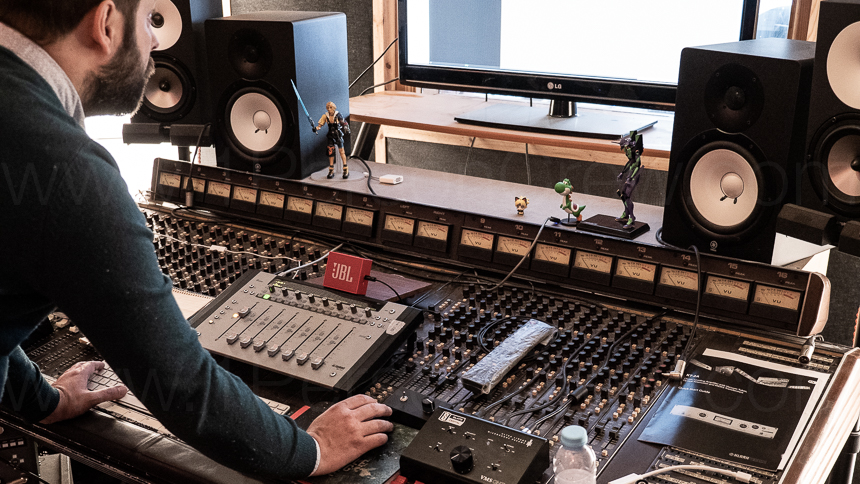
We recorded all the microphones at 48000 Hz Stereo 24 bit, and used the same output settings to export the .wav files from Adobe Premiere Pro.
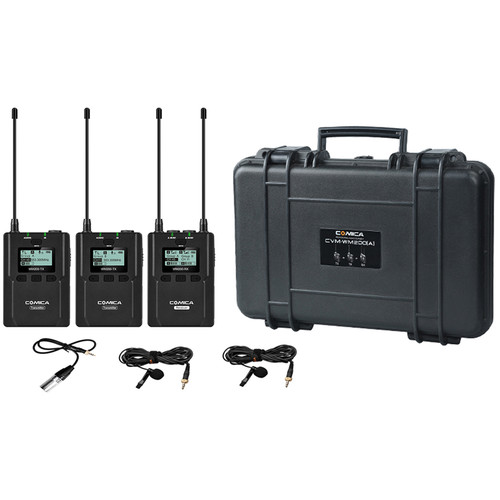
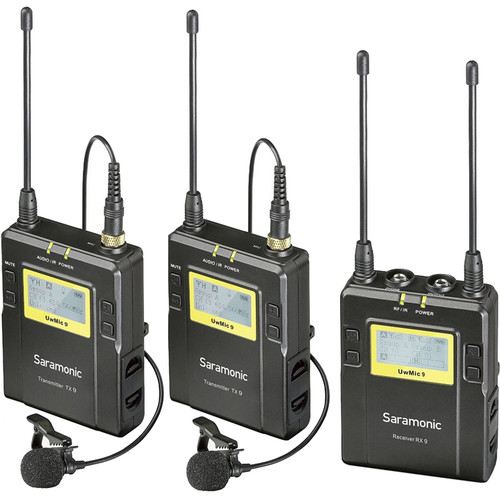
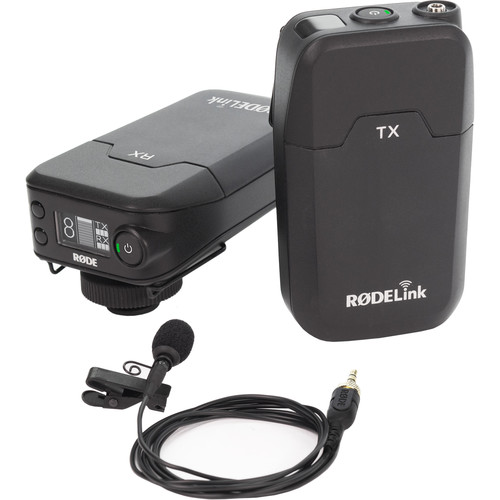
Eduardo’s Comments: The three wireless systems performed very similarly andt he price for the three kits is almost identical. The RodeLink kit recorded more subtle sounds, and the Saramonic a bit less, but overall they seem extremely close.
See Tiago’s Comments at the end of the post.

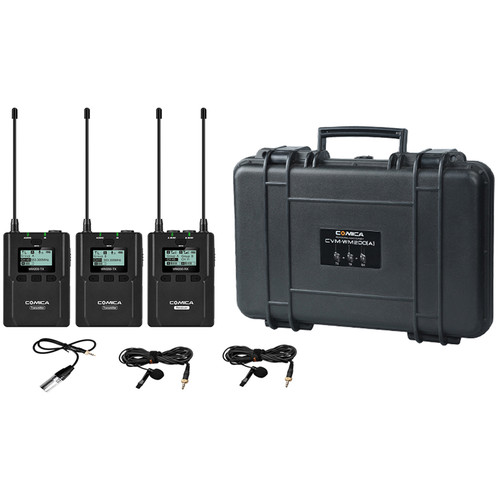
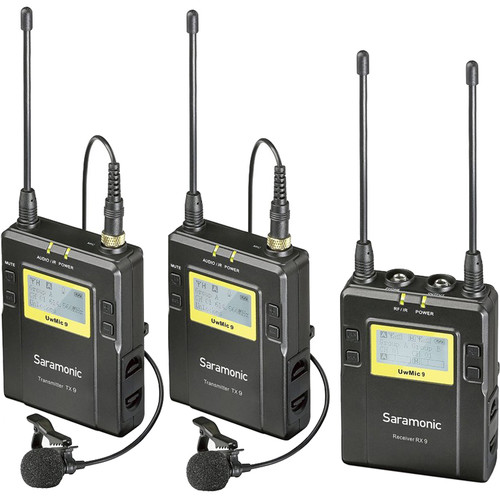
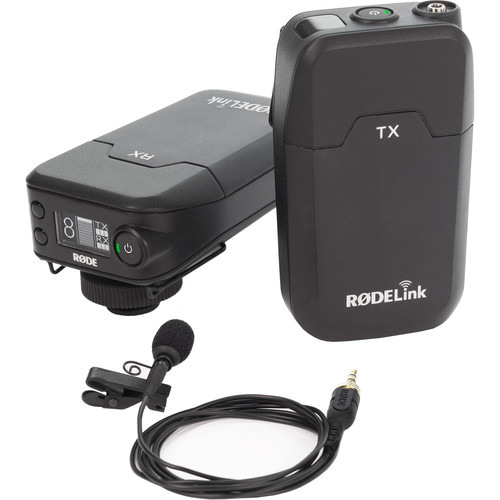
Eduardo’s Comments: The Saramonica and Rode wireless systems are very close, but the Rode seems a bit “crispier. The Comica wireless system captures a less details than the other two.
See Tiago’s Comments at the end of the post.

Tiago’s Comments: The sound from all mics is poor, but this wasn’t a fair test for any of the mics. We should redo the test, adjusting each mic to perform its best and record actual human voices, not a recording.
So here’s a question for you (the reader): If we redo this test, how would YOU like us to test these mics? Write your comments below, send me an email or even a Tweet.
MY VIDEO GEAR
Amazon
ONLINE COURSES
Lynda.com
Mini Tutorials
LinkedIn Learning
SOCIAL
YouTube: 1PersonCrew
Instagram: @1PersonCrew
DISCLAIMER
This article is not paid or sponsored by anyone. It reflects my own independent opinion. I only recommend companies and products that I trust. Some links might be affiliates, which means I may get a few pennies if you decide to purchase something.
Thanks in advance for your support!
In this post I compare 6 different microphones for filmmakers. On the next post I will compare 3 different wireless systems on 2 different configurations each. On both posts you will see the exact gear we used for the tests, and you will be able to listen to how each mic sounds while recording the same exact audio source. Sounds good? Let’s go!
I strongly believe sound is the most important element on a film. We can have the most amazing story, stunning visuals and masterful editing and transitions, but add crappy sound and the viewer will tune out immediately.
For a number of reasons I own different audio sets, but never actually took the time to test them side by side. Until now. A few days ago I called my incredibly talented friend Tiago Canadas who owns Poison Apple Studios, a professional recording studio in Lisbon.
“Poison Apple Studios is a modern recording facility for today´s musician, band, producer, equipped with some of the most cutting-edge and old-school gear within an environment that is dedicated to one thing: creating great music. “

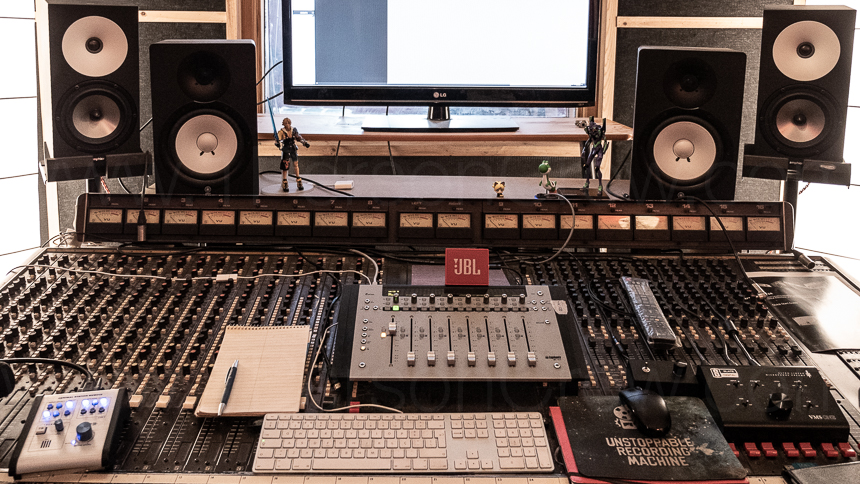
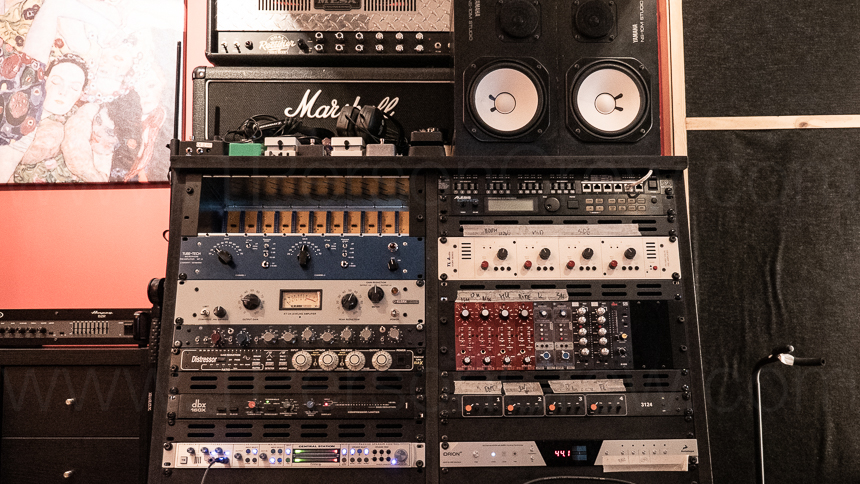
I often joke about how many people spend all their money on a camera, get the kit (aka shitty) lens that comes with it, and if there’s any money left they buy the crappiest tripod in the world. It should be the opposite, as a good solid tripod can last 20 years, a great lens at least 5 to 10 years, and the cameras are being replaced by cheaper, better, faster alternatives every 18 months or less. Well, the same goes with audio gear. You can have a great field recorder and a professional mic, add a low-quality XLR cable and you get low-quality sound.
I’ve set a few professional goals regarding sound for 2019; pay more attention to audio recording while on location, add more sound effects to my projects, get better at choosing the music that enhances the story, and get a better technical understanding of mixing and mastering.
We spent an afternoon designing a test to compare three XLR shotgun mics, three on-camera shotgun mics, three wireless systems connected to a camera, and the same three wireless systems connected to a field recorder.
At some point we considered plugging the mics to Pro Tools and go nuts analyzing the different tracks. But the main goal was to test which mic/system would perform best under real-life situations for people working as a 1 Person Crew, so we chose one of the most popular cameras among indie filmmakers and the most basic field recorder we could find. Tiago chose a 30 second audio clip of a woman singing, and we meticulously set the mics at exactly the same distance and angle from the speakers.

We recorded all the microphones at 48000 Hz Stereo 24 bit, and used the same output settings to export the .wav files from Adobe Premiere Pro.
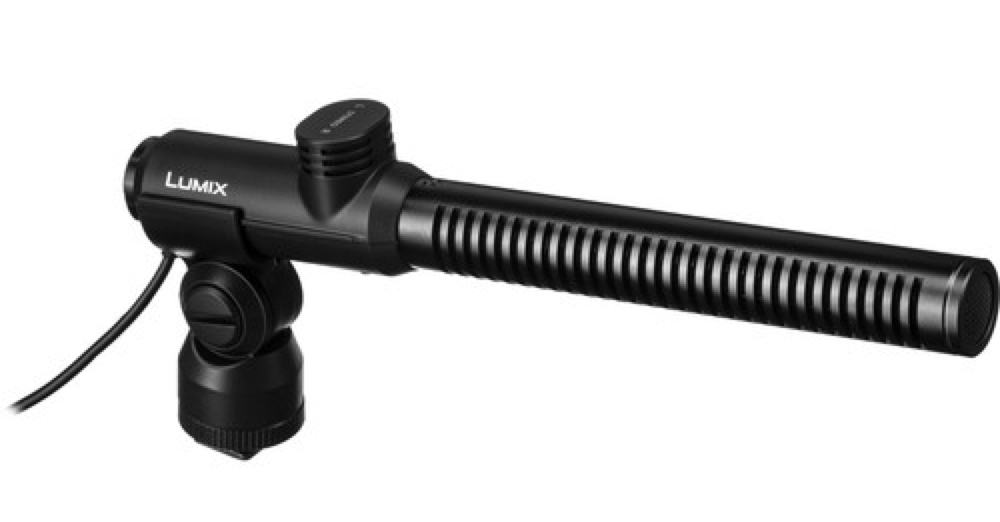


Eduardo’s Comments: Saramonic mini shotgun is as good as the rode video mic go that I’ve used for many many years. The Panasonic shotgun picks up a lot more ambient sound than the other two shotgun mics. The Saramonic Vmic Mini and Rode VideoMic GO seem even in quality (and price).
See Tiago’s Comments at the end of the post.

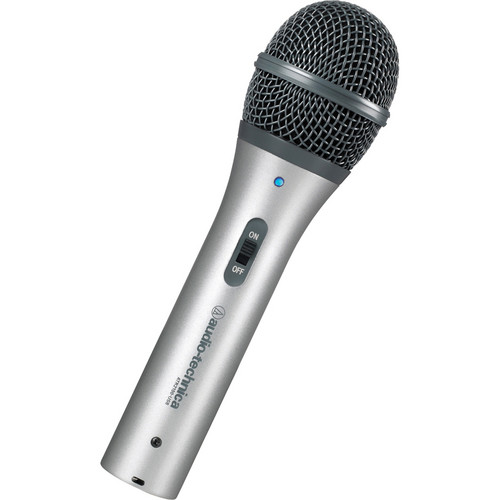
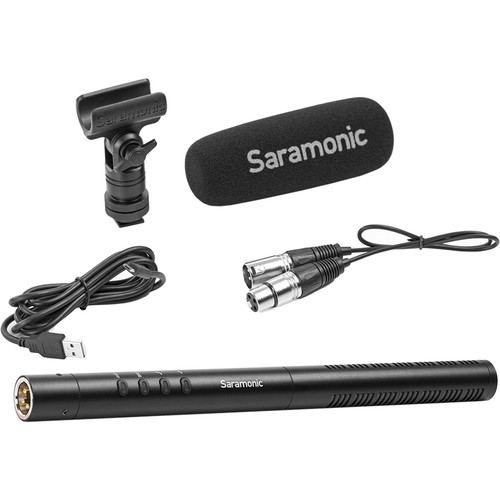
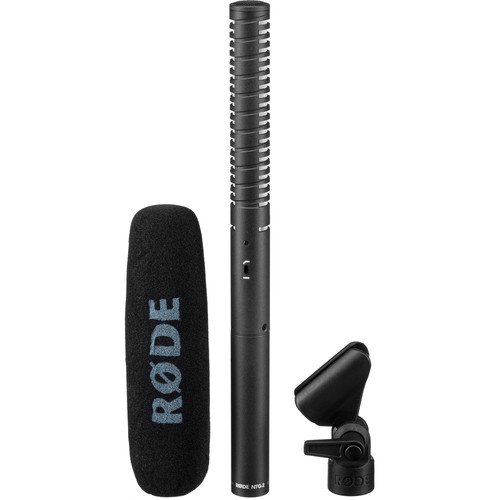


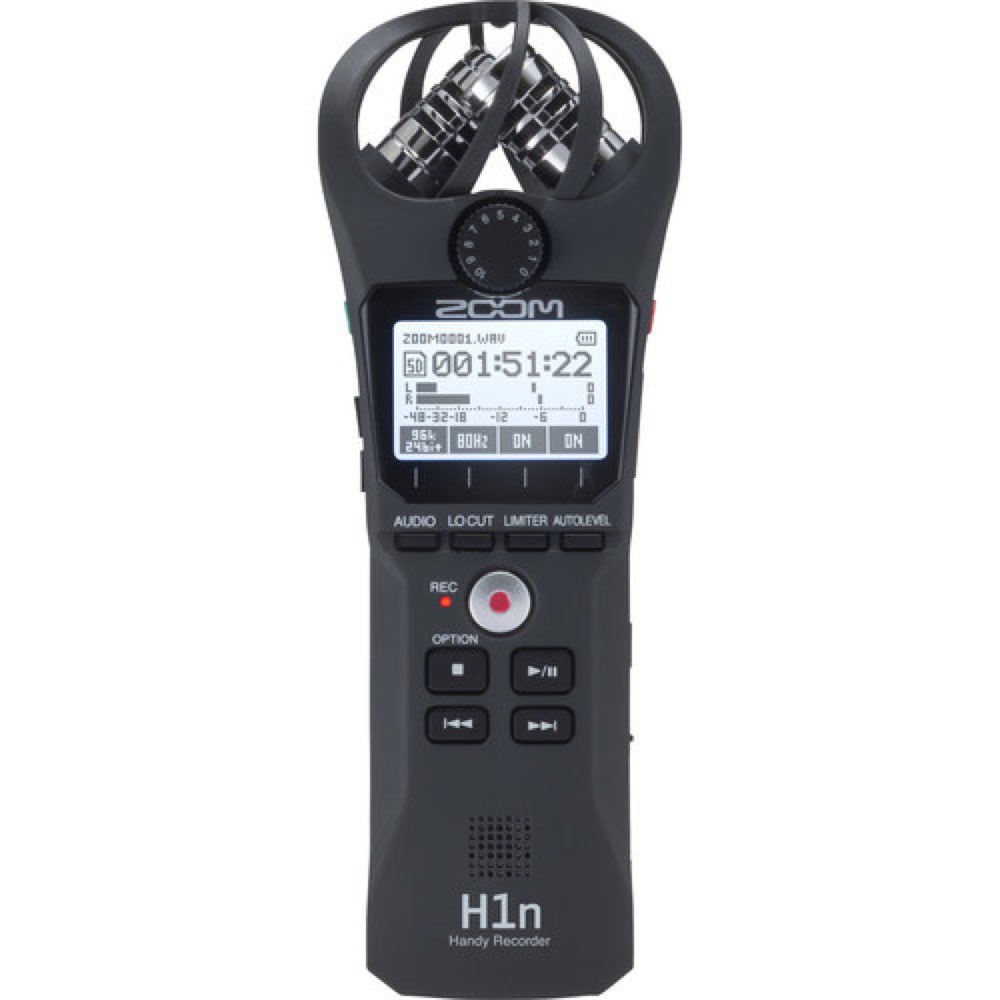
Eduardo’s Comments: This was not a fair competition for the Audio-Technica, as it is a completely different type of mic. The Rode NTG2 has a crisper sound than the Saramonic Shotgun. To me the Rode NTG2 performed better on this test..
See Tiago’s Comments at the end of the post.

Tiago’s Comments: The sound from all mics is poor, but this wasn’t a fair test for any of the mics. We should redo the test, adjusting each mic to perform its best and record actual human voices, not a recording.
On the next post I’ll share the second part of these test, using three different wireless mic kits (with the same set up) on two different recording devices.
So here’s a question for you (the reader): If we redo this test, how would YOU like us to test these mics? Write your comments below, send me an email or even a Tweet.
MY VIDEO GEAR
Amazon
ONLINE COURSES
Lynda.com
Mini Tutorials
LinkedIn Learning
SOCIAL
YouTube: 1PersonCrew
Instagram: @1PersonCrew
Adobe has a free app called Adobe Capture that few people know, and even less people use. Here’s why you might want to start using it today to very quickly and easily create a cinematic look, and even match the look of movies you like.
The way Adobe Capture works is: You take a picture and the app creates a color patch. Then that patch gets exported to your Adobe Creative Cloud library so you can share it with all the other Adobe applications. I don’t use it that way.
I do use it to recreate the grade or cinematic look of specific movie. To achieve this all I need is to get a screenshot of that movie, create a color patch based on that image, and apply that patch to my footage. These simple steps often get me pretty close to the original look.



Here’s more info:
Pretty cool, right? This is huge for people working under very tight deadlines or who aren’t super technical and don’t want to spend a lot of time learning applications like DaVinci Resolve, Lustre, Nucoda, SCRATCH, or Baselight.
Now, if you ARE interested in learning more about grading, and especially how color affects perception in storytelling, I can’t recommend this book high enough.
Want more? Check this “Amazing Adobe Premiere Pro Tips.”
Comments? Questions? Feedback? All of them are welcomed below.
ONLINE COURSES
Lynda.com
Mini Tutorials
LinkedIn Learning
MY VIDEO GEAR
Amazon
SOCIAL
YouTube: 1PersonCrew
Instagram: @1PersonCrew
On my last post, I shared where to find information about reliable hard drives and a couple of people asked “How is this applicable to a 1 Person Crew video production?”
Well, if I know that a specific 3TB drive from a certain brand has a 50% failure rate, that’s all I need to know to not even consider getting it, regardless its price or features.
Once I know which brands and sizes are the most reliable, I set up my workflow using three hard drives. On this video tutorial I quickly explain why:
Solid state drives are still very expensive, but they tiny, extremely durable, and they are coming down in price.

On location, I like using cheaper internal solid state drives like these to backup my footage.

How are you setting up your hard drives for video production? Leave your comments below.
ONLINE COURSES
Lynda.com
Mini Tutorials
LinkedIn Learning
MY VIDEO GEAR
Amazon
DISCLAIMER
This article is not paid or sponsored by anyone. It reflects my own independent opinion. I only recommend companies and products that I trust. Some links might be affiliates, which means I may get a few pennies if you decide to purchase something.
Thanks in advance for your support!
SOCIAL
YouTube: 1PersonCrew
Instagram: @1PersonCrew